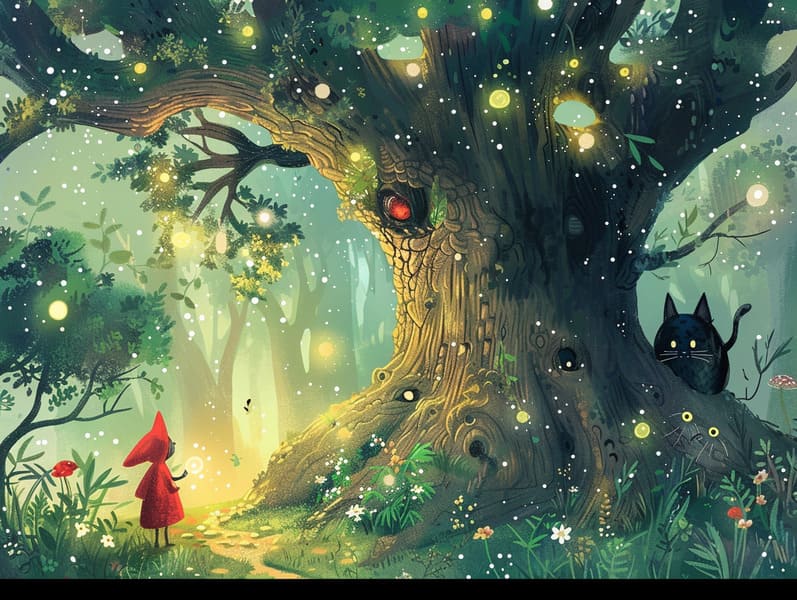
Legendary fairy tales have deep roots. These stories have been whispered from one generation to the next ages before they were ever put on paper. They developed from a variety of civilizations, including Western traditions. They were initially narrated among adults, often carrying themes and messages related to the societal norms and beliefs of the time.
The famous Grimm duo, the two Grimm brothers, were among the first to collect many of these beloved tales. Their compilation, "Grimm's Folk Tales," included narratives like "Ashenputtel," "The Bread Crumb Trail," and "Little Snow White," which have since become pillars in the world of timeless fairy tales. Similarly, Andersen's imaginative stories, such as "The Little Mermaid," and "The Duckling's Story," have stolen hearts worldwide, solidifying their place in the pantheon of treasured fairy tales.
Though they are centuries old, fairy tales remain as meaningful as ever, especially as children's night stories. These fantastical tales are now available in different formats, including artistically illustrated books, delightful animations, and web-based fairy tales.
Their enduring popularity can be connected to several magical reasons:
Life Lessons: Traditional fairy tales often present important moral lessons. Fairy tales like "The Boy Who Cried Wolf" teach the significance of being truthful, while "The Hare and the Tortoise" exemplify the virtues of persistence and unpretentiousness. These tales offer young readers clear distinctions between good and bad, molding their moral compass in a gentle yet significant way.
Compassion and Insight: Timeless fairy tales frequently portray figures facing tests and troubles, provoking young readers to feel with their struggles and celebrate their triumphs. For instance, "The Story of Beauty and the Beast" reveals the importance of seeing beyond the surface to see the true nature of a soul, enhancing compassion and recognition.
Cultural Knowledge: Many ancient fairy tales are rooted in the cultural contexts from which they emerged. Engaging with these tales can provide delightful insights into different heritages, advancing a sense of cultural appreciation and awareness.
Imagination and Innovation: The mythical elements in timeless fairy tales—mythical entities—motivate children’s fantasies. These stories take readers to magical realms, invigorating creative dreams and a sense of magic that persists a lifetime.
Timeless fairy tales are not only bewitching but also informative. They function as magical tools in developing various cognitive and affective skills in children. When old fairy tales are spoken out loud, they nurture language skills by teaching new words and complex sentence structures. This practice also promotes auditory perception and mental focus, as young ones concentrate deeply, anticipating to see what happens next.
Furthermore, contemplating the themes and characters of ancient fairy tales can cultivate reasoning skills and analytical skills. Children are taught to find patterns, forecast, and realize cause and effect. These discussions also ease little ones convey their thoughts and feelings, boosting their emotional intelligence.
In today’s online age, the presence of web-based fairy tales has made these tales more acquirable than ever. Online resources and applications supply comprehensive collections of bedtime fairy tales that can be read or listened on anytime, anywhere. Fairy tales voiced are particularly liked, offering an entertaining method for young readers to take part in these captivating stories. Narrated books and read-to-me videos lead characters and settings to life, often joined by captivating audio effects and tunes that intensify the story adventure.
The timeless appeal of classic fairy tales lies in their ability to adjust to changing times while maintaining their core values. Contemporary modernizations of these narratives often show more multicultural figures and modern settings, making them pertinent to today’s audience. However, the essential messages of valour, kindheartedness, and honesty remain unchanged, continuing to resonate with young readers of all ages.
Traditional fairy tales also offer a sense of security and closeness. They deliver a well-structured narrative with a unmistakable beginning, middle, and end, often drawing to a close with the conclusion of conflicts and the triumph of good over evil. This uniformity can be reassuring for young ones, furnishing a sense of constancy in an shifting world.
Old fairy tales continue to fascinate and edify new generations, maintaining their loveliness and value in modern society. As bedtime stories for kids, they allow a perfect blend of magic and knowledge, enhancing moral values, empathy, and creativity. The prevalence of internet fairy tales and the well-received status of fairy tales recited make sure that these ancient tales remain available to new generations.
By guarding and conveying these tales, we continue to treasure the rich tapestry of storytelling and cultural heritage. Whether you are viewing a richly illustrated book, seeing a virtual library, or listening through an read-aloud book, fairy tales the splendor of timeless fairy tales is always within reach. These narratives reveal of the undying presence of fairy tales and its ability to unite us across epochs and places.
No matter if you are seeing a vibrantly illustrated book, delving into a digital library, or listening to an audio story, the elegance of timeless fairy tales is always within reach.
These tales show us of the consistent presence of fairy tales and its ability to hold us together across generations and cultures, forging a link that enchants and educates alike.